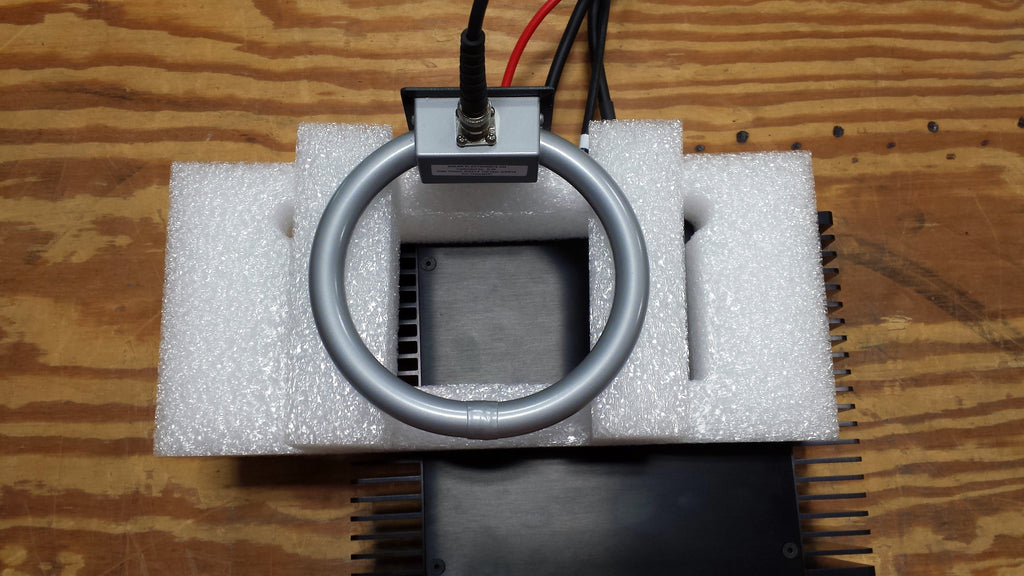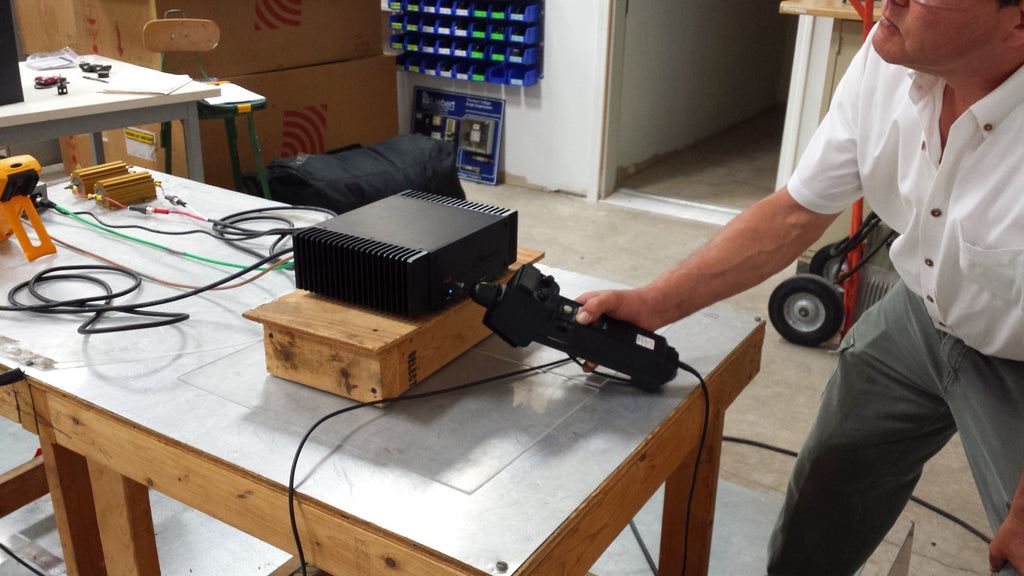Buy one component and save 10% on up to 2 cables. Buy 2 components and get 4 free cables. Free shipping on USA orders over $700.
Buy one component and save 10% on up to 2 cables. Buy 2 components and get 4 free cables. Free shipping on USA orders over $700.
The CE Mark - A Photo-Tour of Immunity Testing
by John Siau June 25, 2014

Most people have seen the CE mark on electronic equipment, but few have had the opportunity to witness the tests that are required to conform to the CE specifications. This post takes the reader on a behind-the-scenes photo-tour of the CE tests of Benchmark's new AHB2 power amplifier.
The CE mark is a manufacturer's declaration that the product has passed a comprehensive set of tests to evaluate the ability of the product to operate in close proximity to other electronic products. This means that the product must be immune to interference caused by nearby products, and that it must not emit excessive interference that could cause problems to nearby products.
There are two parts to the CE tests - immunity and emissions.This photo-tour focuses on the immunity tests.
Photo 1 - Immunity to Radio Interference

Photo 1 shows the AHB2 being exposed to high levels of Radio Frequency (RF) interference.
The transmitting antenna (which looks like a giant egg beater) is positioned in front of the AHB2. The spherical object on top of the AHB2 is an RF field strength probe. During these tests, the radio interference is swept over a wide range of frequencies while the product is rotated to maximize exposure on each of four sides.
As a professional product, the AHB2 must continue to operate at full performance under these test conditions. In contrast, consumer products are subjected to lower RF levels and are permitted some loss in performance.
These tests are performed in a shielded room. The high-power radio signals used in these tests must not be allowed to escape the room where they could interfere with radio communications systems. RF absorption panels on the walls help minimize reflections of the RF energy to improve the uniformity of the interfering signal.
Photo 2 - Immunity to Magnetic Fields

Photo 2 shows the AHB2 being exposed to a magnetic field.
The coil induces a magnetic field at frequencies between 50 Hz and 15.75 kHz to test for magnetic immunity. The coil is held at a precise distance while scanning all surfaces of the device under test. The AHB2 has two layers of magnetic shielding, and easily passes this series of tests.
This is part of a special series of tests for rack-mounted professional products. Consumer products are subjected to lower magnetic field levels and are only tested at 50 or 60 Hz. This difference underscores the importance of selecting professional products for use in the studio.
Photo 3 - Immunity to Electrostatic Discharge

Photo 3 shows a technician zapping an AHB2 with a high-voltage discharge. All sides of the product must be able to withstand direct and indirect discharges, and the product must continue to function normally. This test is is designed to insure that your speakers do not make a noise if someone walks across the carpet and touches the power amplifier.
Consumer products are subjected to the same tests but are allowed non-permanent malfunctions. A pop or crackle from the speakers would be considered acceptable from a consumer power amplifier. The standards allow a complete shutdown or reboot of consumer-grade products as long as no permanent damage is sustained.
Photo 4 - Immunity to Power Line Surges

Photo 4 shows some of the equipment used to expose the product to power line surges, dips, and brownouts.These test standards minimize the chances that a product will fail due to power line surges.
Photo 5 - Immunity to Conducted Interference

Photo 5 shows some of the apparatus used to inject interfering signals onto the input and output cables of the AHB2. This test shows capacitive coupling of an interfering signal. Other tests use direct injection, while others use magnetic coupling. Together, these test are designed to cover all possible means of interference.
CE tests vary by product type, intended application, and intended environment. See The CE Mark - What Does it Mean, and Why Should I Care? for more background on the CE tests.
Leave a comment
Comments will be approved before showing up.
Also in Audio Application Notes

How Loud is the Distortion from Your Power Amplifier?
by John Siau August 08, 2025
Would you put a Washing Machine in your Listening Room?
If the answer is no, you may be surprised to discover that the distortion produced by your power amplifier may be louder than the noise produced by a major appliance.
Don't believe me? Take a look at Stereophile's test reports:
We selected 7 power amplifiers from Stereophile's top list of recommended amplifiers.
We took Stereophile's "THD+N vs. Power" plots for each, and replotted the data in a format that shows the loudness of the THD+N at the listening position.
The results are shocking!
Amplifier THD+N is louder than expected!
The distortion from your amplifier may be louder than a washing machine on the spin cycle, or it may be totally silent. How does yours perform? The answer is hidden in Stereophile's THD+N plots.
This application note reveals the hidden truth:
"The Distortion from your Power Amplifier may be Louder than a Washing Machine!"
I know, it sounds crazy, but this is what the measurements show!

Interpolator Overload Distortion
by John Siau November 20, 2024
Most digital playback devices include digital interpolators. These interpolators increase the sample rate of the incoming audio to improve the performance of the playback system. Interpolators are essential in oversampled sigma-delta D/A converters, and in sample rate converters. In general, interpolators have vastly improved the performance of audio D/A converters by eliminating the need for analog brick wall filters. Nevertheless, digital interpolators have brick wall digital filters that can produce unique distortion signatures when they are overloaded.
10% Distortion
An interpolator that performs wonderfully when tested with standard test tones, may overload severely when playing the inter-sample musical peaks that are captured on a typical CD. In our tests, we observed THD+N levels exceeding 10% while interpolator overloads were occurring. The highest levels were produced by devices that included ASRC sample rate converters.

Audiophile Snake Oil
by John Siau April 05, 2024
The Audiophile Wild West
Audiophiles live in the wild west. $495 will buy an "audiophile fuse" to replace the $1 generic fuse that came in your audio amplifier. $10,000 will buy a set of "audiophile speaker cables" to replace the $20 wires you purchased at the local hardware store. We are told that these $10,000 cables can be improved if we add a set of $300 "cable elevators" to dampen vibrations. You didn't even know that you needed elevators! And let's not forget to budget at least $200 for each of the "isolation platforms" we will need under our electronic components. Furthermore, it seems that any so-called "audiophile power cord" that costs less than $100, does not belong in a high-end system. And, if cost is no object, there are premium versions of each that can be purchased by the most discerning customers. A top-of-the line power cord could run $5000. One magazine claims that "the majority of listeners were able to hear the difference between a $5 power cable and a $5,000 power cord". Can you hear the difference? If not, are you really an audiophile?

